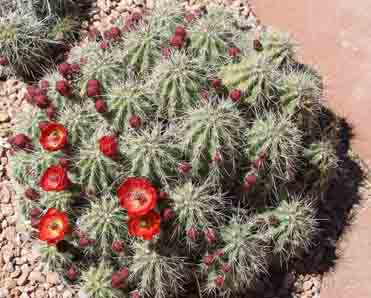The Plant w/Flowers

The Flowers

Description
"Duration: Perennial General: Hedghog-like cactus, consisting of many small cylindric stems tightly aggregated together in clumps or mounds up to 1 m wide; stems 20-100 or more per mound or clump; each stem erect, cylindric to spheric, 5-40 cm tall and 4-15 cm in diameter, with about 9-12 ribs; ribs slightly or conspicuously undulate, with areoles (axillary buds from which the spines emerge) usually 1 cm apart at the crests of the undulations. Spines: Spines usually 5-16 per areole, mostly straight except on unusually long-spined individuals, the spine color white to yellow, reddish-brown, or black, and often dark tipped; about 3-4 of these are central spines, which are 1-6 cm long, project outward, and are round in cross section or occasionally subulate (awl-shaped, or wider at the base); the rest of the spines are radial (emerging from the outside edge of the areole), 5 mm to 3 cm long, and appressed to the cactus stem or slightly projecting away from the cactus. Flowers: Plants dioeceous (with male and female flowers on separate plants), or flowers bisexual; flowers 3-9 cm high and 2-7 cm wide; petals 2-4 cm high and 1-16 mm wide, red, sometimes orange, or rarely pink or white, sometimes paler at the base, with thick, rigid tips; anthers usually pink or purple (rarely yellow); stigma lobes green. Fruits: Fruits juicy and spiny, 2-4 cm long, the skin usually brownish or reddish, sometimes green, and the inner pulp white; seeds dark colored, 1-2 mm long. Ecology: Found on bajadas, rocky slopes, and cliffs, on igneous, metamorphic, and limestone substrates, associated with a wide variety of vegetation community types from Chihuahuan desert up to montane conifer forest, below 10,000 ft (3048 m); flowers late March-J Distribution: AZ, CO, NM, TX; south to n MEX." (SEINet)
Ethnobotanical Uses
Food:
"Hedgehog cacti, with their larger and probably tougher stems, were sometimes roasted in a pit. Years ago ethnobotanist Vlney H. Jones recorded the eating and preserving of the fruits of of one of the hedgehog species, the spectacular Echinocereus triglochidiantus, know as claret cup cactus, at Isleta Pueblo: 'The pulp is prepared in a variety of ways. It may be sliced and baked as squash is prepared. A sweet pickle is made by baking it with sugar. Cakes and candy are made from it in much the same way (Jones, 1931).'" (Dunmire and Tierney 191)
Internet Resources